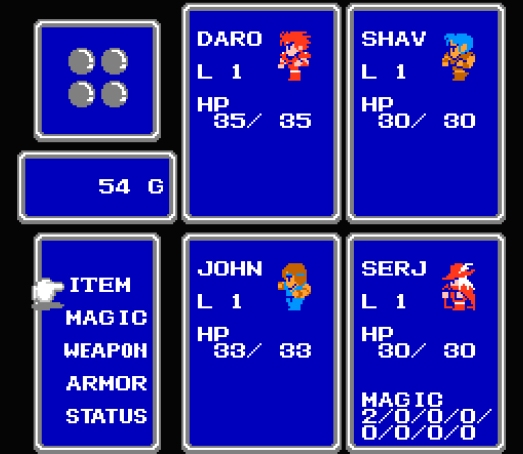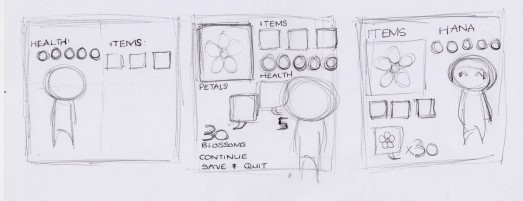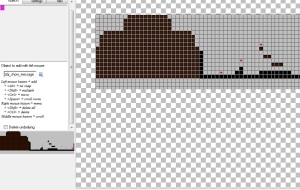Traditionally, I think the HUD was the most appropriate display of information for Platform games. GUI designs and formats seem to be very genre specific, and dependent on the type of information the player needs to customise. If the customisable info is limited, then a simple and very minimal system is required. For games where play is based on the customisation of various items and objects, the system is more complex.
If you look back to the original Super Mario Bros (which I know I refer to all the time, but you’ve really got to consider it to be the great grandfather of all great Platformers to follow!) all the information that the player needed to know were displayed in a dedicated space at the top of the screen. On the left you have player information: the player’s score and the amount of coins collected. On the right you have the level information: the current level and the time that the player has left to complete the level. Items are collected throughout the game, but they are put to effect immediately.

Adventure game Legend of Zelda had a greater need for an inventory system where the player could scroll through items that they had collected. In LoZ, the player must collect many items which have various uses. Some are offensive items such as bows and arrows or explosives, others are keys which unlock certain parts of the level, and of course, the player must find and collect the three parts of the Triforce. This need led to a specific menu design where items were arranged according to type. At the top you have selectable items which the player is carrying but may not necessarily be equipped. Having a list of stored items allows the player to pick and choose when items are used. Below this are un-selectable bits of information which cannot be changed or customised. In the middle there is a little diagram showing how many Triforce pieces have been collected. The bottom row of information is the same as the play sees in the HUD, and is a quick breakdown of map position, money and keys collected, items equipped and health points.

The RPG (Role Playing Game) Final Fantasy (the great grandfather of a dying breed of great RPGs) takes the inventory menu to the next level. Here we have a grid of information which is split into three sections. The diagram in the top left corner shows the amount of elemental orbs that player has collected. Below this is the amount of money the player has collected. Both of these pieces of information are non-customisable, and are simply a display. In the bottom left hand corner is a list of links to separate menus containing information about the customisable items that the player has collected such as magic, weapons and armour collected. The success of the game revolves around decisions that the player makes in these menus- if ignored the player cannot progress. The right hand side of the screen is dedicated to displaying character information. This is a quick overview of each character, and is easily accessible as there is no HUD system in this game.

These three games were all designed for the Nintendo Entertainment System in the 1980s, but these GUI types have run with each genre throughout gaming history. As Hanami is essentially a 2D Platformer, history dictates that an inventory menu is unnecessary. However, it has evolved and changed at times. In Super Mario Bros 3, the player was given the chance to collect an item at the end of each level. Up to three items were then stored which the player could choose to use between levels, essentially creating an inventory system which was a part of the HUD- shown at the bottom right of this screenshot.

Although it makes a game more challenging to use items immediately on collection, there’s something fair and tactical about allowing players to save up items and use them at their discretion. This is why I’ve chosen to allow the player to collect healing sushi throughout Hanami and only consume when see fit. This gives me the chance to provide a window of extra information for the player, or previously displayed info in more detail! I’ve taken design inspiration from a range of existing menu designs in games. As I was looking through various games that I’ve played, I realised that coincidentally most of my favourite menu designs are from Gameboy Advance games. For reasons I can’t explain, it just seems like they put a lot of effort into awesome menus for GBA titles.
What I like about…
…The Harvest Moon More Friends of Mineral Town Inventory

It’s simple, colourful and interesting! The inventory has a certain amount of slots which are either empty or occupied by an image of an item. When an item is hovered over, information is displayed in the info box at the bottom. The system is easy to use and understand because it is set up into a nice grid system and split into two categories: tools and items. The colours and thumbnail pictures are just nice.
…The Final Fantasy Tactics Advance Menus


Far from simple, this menu system actually takes a while to get your head around. Once you do, you can start to appreciate how attractive the whole thing is, and how consistently stylised it is, even in very varying circumstances! Most things that the player must control are inside blue-window boxes, while statistics and other pieces of information are placed in a non-accessible background. Like the example from Harvest Moon, clear information is shown before the player makes critical choices.
…The Kingdom Hearts Chain of Memories Menus

The menu system in Kingdom Hearts stretches across hundreds of pages, but all of these pages are very accessible with only a few clicks. The system has been designed so that they player can view only the information they want to view very easily, using things like menu tabs to flick through pages.























































